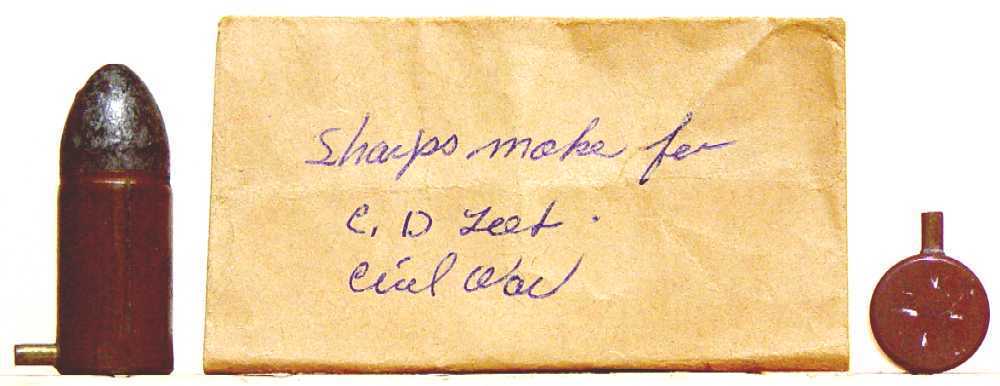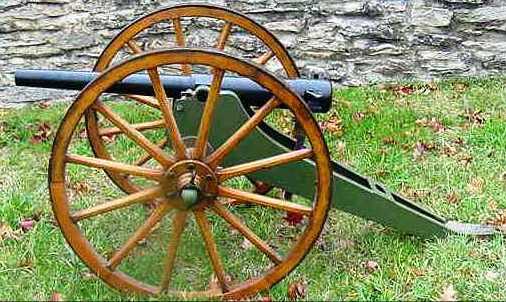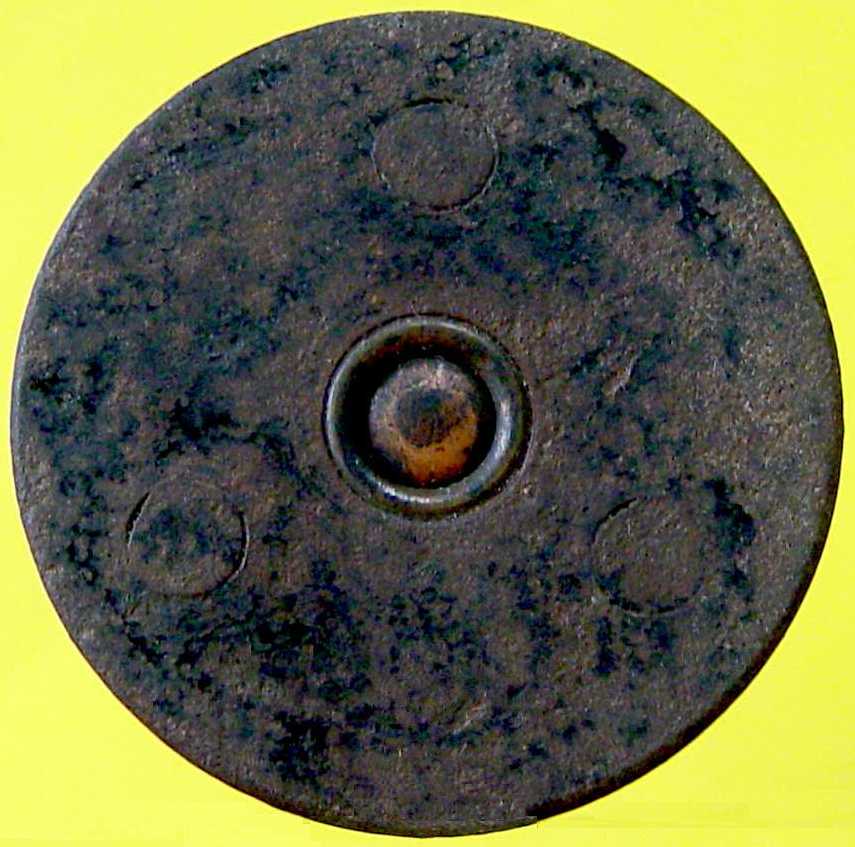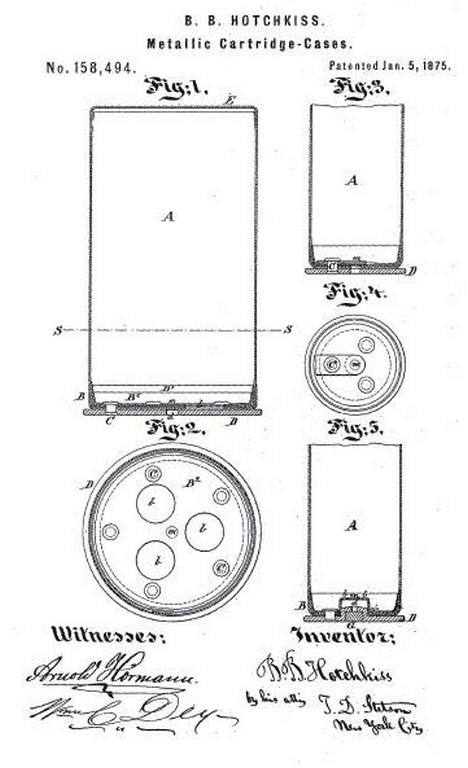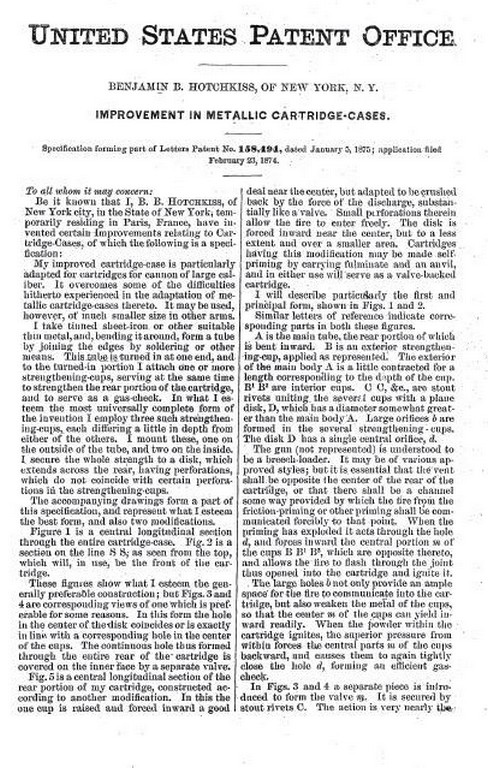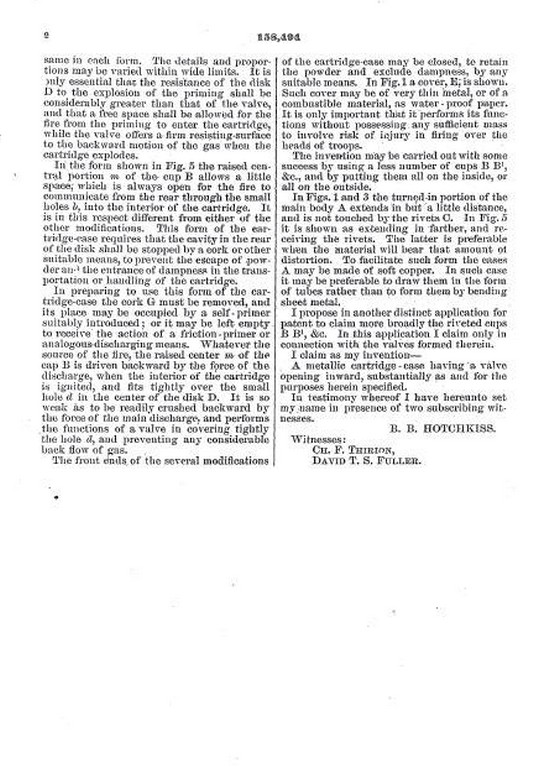|
THE CARTRIDGE COLLECTOR'S EXCHANGE |
| Contents
Cartridge
Lists
Prior Picture Pages:
Links to Other Sites
Cartridge Collectors Organizations:
Auctions:
Books:
Other Collector's Sites:
|
Home of the Old Ammo Guy's Virtual
Cartridge Trading Table
Picture Page November 2009 An American-made 12mm pinfire cartridge.......
The 12mm pinfire cartridge shown here came from the Frank Sellers estate, and was included in a large assortment of his cartridges purchased in a recent auction. All of the cartridges were in small hand-labeled envelopes. This envelope appears to be labeled 'Sharps make for C. D Leet Civil War', which I would interpret to mean the cartridge was made by Sharps for C. D. Leet during the Civil War. On the other hand, the label could be 'Sharps make frm C.D. Leet', which might be interpreted to mean that it is a Sharps make (or style) cartridge from C D Leet. Although the Sharps Rifle Manufacturing Company bore his name, Christian Sharps wasn't its principal owner, but served as a technical advisor, receiving a royalty for each firearm produced. In 1854 he formed C. Sharps & Company to make a single shot percussion handgun and rifle, and in 1859 began producing four barrel pepperbox pistols. In 1862, Sharps formed a partnership with William Hankins, known as Sharps & Hankins. That company continued manufacturing the four-barrel pepperboxes, as well as single-shot breech loading .52 rimfire rifles and carbines, many of which were sold to the Army and Navy during the war. The partnership ended in 1866, due most likely to the almost demand for firearms at the close of the Civil War, and Sharps returned to the C. Sharps & Company name again, resuming production of four barrel pepperboxes. C. Sharps & Company ceased operations with Sharps' death in 1874. Christian Sharps is well known for the variety of firearms that bear his name, but few are aware that he also secured a U.S. Patent in 1862 for improvements to the pinfire cartridge. These improvements thickened the base of the cartridge to help it hold its shape after firing, reducing the possibility of the cartridge bases bulging and interfering with the rotation of the revolver cylinder. That the cartridge shown in the pictures was not made by Sharps is pretty certain. While Sharps & Hankins produced over two million rimfire cartridges on contract for the Army and the Navy, they are not known to have manufactured pinfire cartridges. Nor was the cartridge shown above made by C. D. Leet; it was actually made by Ethan Allen. While Leet is known to have made 12 mm pinfire cartridges, the identification of this cartridge as a product of Ethan Allen has been made based on the characteristics of the case, with its rounded edges on the base and the tic marks (highlighted with chalk to make them easier to see) on the head. That Sharps had a patent on an improvement in pinfire cartridges is surprising, as his name is not associated in any way with pin fire firearms. However, it is possible that, having secured a contract to supply pinfire cartridges to the government, he recognized a weakness in the cartridges that were being produced at that time, saw the thicker base as a means of remedying that weakness, and applied for the patent to ensure he would be compensated should any ammunition manufacturer choose to use his design. Apparently, Sharps licensed both Ethan Allen and C. D. Leet to manufacture pinfire cartridges using his improvement, as both companies are known to have produced these cartridges with the thick heads. Frank Sellers makes reference in his book Sharps Firearms to 54,600 Lefaucheux cartridges that Sharps & Hankins sold to the U.S. Army during the Civil War. While no particulars are given, it can be assumed that these were 12mm pinfire cartridges, as the US government procured in excess of 12,000 Lefaucheux 12mm pinfire revolvers for use during the war. It is probable that Sharps & Hankins contracted with Ethan Allen, C. D. Leet, or both companies to produce the pinfire cartridges needed to satisfy its contract with the government, and that the cartridge shown above is one of these.
.
A box of .38 S&W 'Long' cartridges.........
This box of German cartridges was made by Braun & Bloem, Dusselforf, and is labeled as central fire cartridges for use in the Smith & Wesson .38 automatic ejecting revolver. With its birds head grip, the revolver shown on the label appears to be a Smith & Wesson Model 1 1/2 Single Action, which was actually a .32 caliber revolver. The small 'LANG' label translates to 'long', which suggests that the cartridges in the box are .38 S&W longs, a cartridge that is not recognized by that name by collectors. The cartridges in the box are headstamped S&W 38. The dimensions are: bullet (measured at the case mouth) - .356" neck - .380" base - .383" rim - .437" case length - 1.044" overall length - 1.370" The dimensions of the cartridge fall within the ranges that Brandt lists for the inside lubricated .38 Long Colt, and should function well in a Smith & Wesson revolver intended for the .38 Special cartridge However, this cartridge is too long for the S&W revolvers of the top break style, as illustrated on the label, due to their stepped chambers which do not allow the cartridge to be fully inserted in the cylinder. In addition, were the chamber bored straight through, the bullet would extend beyond the end of the cylinder, preventing the cylinder from rotating. When I first received it, this box had a small 'Made in Germany' label pasted over the makers name (Braun & Bloem), which has since come loose. This label indicate that the box was imported to the US sometime after 1898, when the country of origin was mandated on imported goods. . . An early Hotchkiss 1.65" (2 pound) cartridge.......
Brigadier-General Steven Vincent Benet included the following in the 1878 Report of the Chief of Ordnance regarding the Hotchkiss mountain breech-loading rifle: "Early in 1876, Colonel Miles, Fifth Infantry, suggested that a light field-gun weighing less than 500 pounds be provided for service on the plains, to replace the obsolete mountain howitzer. The subject was submitted to the Ordnance Board for consideration, with the remark "that a rifled gun, probably a breech-loader, that can travel with cavalry, and has an effective shell range beyond that of rifled small arms, not less than 1,500 yards, would probably meet the requirements of the service". While under consideration, Mr. B. B. Hotchkiss presented for examination and trial a light breech-loading rifle that gave promise of efficient service on the frontier, and fulfill(ed) the conditions of mobility, range, and accuracy. One was procured and issued to the Department of Dakota in 1877, and used in the field that summer. It weighs 116 pounds, and its caliber is 1.65 inches. It uses a charge of 6 ounces of powder, and a percussion shell weighing 2 pounds. While many defects in its mechanism, and in the carriage and ammunition, have been pointed out after the experience of a campaign, showing that modifications are desirable to add to its effectiveness, it did excellent work. I am informed that Colonel Miles expressed himself as satisfied that it had rendered efficient service, and was a valuable weapon. With all its defects, others have been called for, and the five now in possession of the department will be issued to the troops." That first Hotchkiss mountain rifle that accompanied Colonel Miles on his Summer of 1877 campaign saw its inaugural action against the Nez Perces at Bears Paw on the afternoon of September 30, 1877, but there is no indication that it was actually fired. It should be noted that there was a connection between Hotchkiss & Cie and General Benet. The General and Hotchkiss were long time friends, and the General's son Lawrence V. Benet was an employee of the company. Upon the death of Benjamin Hotchkiss, Lawrence Benet became Chief Engineer of Hotchkiss et Cie, Paris, resulting a strong relationship between U.S. and French arms development.
The patent drawings and specifications shown below explain the construction of the early friction primer fired case fairly well, and these pictures of the exterior (left in the picture below) and interior (center) of the head of the case help to illustrate how the patented design of the head worked. The body of the case is formed from sheet brass that is wrapped around a mandrel and the bottom edges folded over to form a closed base. This base is fitted into a shallow brass cup to give it more strength. An iron disk that forms the head and rim of the cartridge case is attached to the base with three rivets. In the center of the iron disk, as small (.150") hole is drilled that passes through the brass cup and inside the case. This is the ignition hole which is intended to allow passage of the the flash from a friction primer into cartridge case to ignite the powder charge. On the inside of the head is the diaphram, a thin brass disc with three circular cutouts equally spaced apart. When the friction primer exploded, it was with sufficient strength for the resulting flash to travel through the center ignition hole in the head, forcing the center of the interior disc forward slightly, and passing through the three cutouts to ignite the powder charge. The resulting explosion of the powder charge would force the disc back against the interior of the case head forming a gas check that sealed the ignition hole in the center of the head.
. . . . . The cartridge head shown on the right side in the picture above is a later style Hotchkiss case, which constructed of wrapped sheet brass and a separate brass strengthening cup and iron head like the earlier case, but which is fitted with a conventional primer.
. . . . . . . . . . . . . . . . . . . . . . .
.
The picture of the Hotchkiss mountain gun is from the web site of the Cannon Superstore at http://www.cannonsuperstore.com/hotchkiss.htm. .
|

